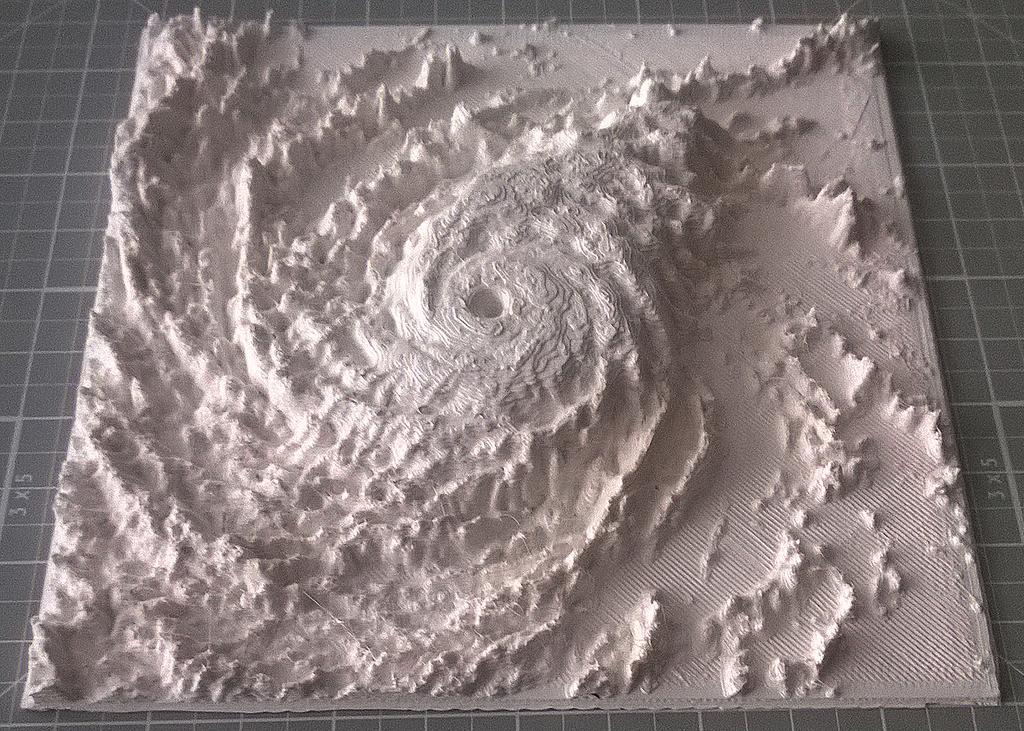It’s really quite incredible to watch as new applications for 3D printing come about. Pretty much every field imaginable has at least some use for this incredible technology, which only has begun to get noticed. Last week, we saw how one man, named Doug McCune, 3D printed the USGS Earthquake Data from last month’s quake in the Napa Valley area of California. It turns out that this is not the only 3D print of a natural disaster currently available.
Francis Reddy, a science writer who’s on contract with NASA’s Goddard Space Flight Center, and author of several books related to astronomy and space science, has 3D printed a hurricane.
Every year, in the United States alone, there are tens of millions of people at risk from hurricanes, mainly in the Atlantic basin, which includes the entire eastern seaboard, as well as the coast of the Gulf of Mexico. This year, however, likely due to a mild El Nino event, has been a bit unusual. The main threat to the United States has been within the Pacific Basin, particularly Hawaii.
On August 7th, Hurricane Iselle became the strongest tropical cyclone in recorded history to make landfall on the Big Island of Hawaii. When all was said and done, the total damage to the State of Hawaii was estimated at around $80 million, mostly attributed to crop losses. On the heels of Iselle, was another Hurricane name Julio, which many computer models predicted could also affect the state. In the end, the hurricane passed well north of Hawaii, sparing the island state from a one-two punch. It was this hurricane, which Reddy decided to 3D print.
“The time-consuming thing was finding the right set of image,” explained Reddy to 3DPrint.com. “You want flat lighting because in this technique the gray value of the pixel is translated to height, so highlights from sunlight striking the clouds at an angle create false elevations. The infrared image doesn’t have this problem, but the visible image, which reveals the most detail, does. Once I found what I was looking for, I merged the images in a way that was pleasing to me, generated and simplified the mesh, and sent it to the printer.”
The two images he used were taken at a near perfect angle by the GOES 15 satellite. One image was the actual visible satellite photo, while the other was the infrared enhanced satellite used to show the temperatures of the cloud tops, and thus the heights of the clouds. Colder and higher cloud tops usually represent the stronger cells within the storm.
The images were taken at 2100 UTC on August 7, when Julio was a Category 2 storm, centered around 17.1 degrees north latitude, and 137.7 degrees west longitude. The final print came out quite well, showing the varying heights of clouds in relation to one another, based on the brightness of the pixels within the infrared image. The model was 3D printed by Reddy on a Da Vinci 1.0, using stock ABS.
“The first two attempts suffered warping issues so bad they could not be completed. I began using ABS juice and have not had a problem with warped prints since,” he explained.
Reddy’s model has been provided to NASA, who has responded by allowing the public to download the .stl file free of charge, enabling anyone with a 3D printer to fabricate their own version of Hurricane Julio. The default size of the model, when printed, is 5.3 inches per side, representing an actual distance of 787 miles. The model, in .stl format, can be download here.
As for Reddy’s future plans, he gave us some insight into what he may work on next:
“One thought is to combine terrain and bathymetry data with images of hurricanes making landfall, perhaps with each data set as individual models so they could be rendered in separate colors or painted more easily. That could [be] quite striking. I’m working on a model of an extraterrestrial storm system, but I’m not yet happy with the results.”
Reddy wanted us to stress that this 3D print is more of an art form than a scientific model. He is not a scientist and is only a beginner when it comes to 3D printing. Despite this, the project is certainly an interesting one, which hopefully Reddy as well as others can continue to expand upon.
Let’s hear your thoughts on Reddy’s utilization of 3D printing to better depict a powerful hurricane in the third dimension. Discuss in the 3D printed hurricane forum thread on 3DPB.com.
Subscribe to Our Email Newsletter
Stay up-to-date on all the latest news from the 3D printing industry and receive information and offers from third party vendors.
You May Also Like
New Report: Semiconductor Industry to See $1.4B in 3D Printing Revenues by 2032
“The semiconductor sector has become the most strategically significant area of global industry.” Truer words are hard to come by when it comes to the modern world, and they are...
Will Photonic-Crystal Lasers Revolutionize 3D Printing?
Powder bed fusion (PBF) for metals and polymers predominantly utilizes lasers as the primary heat source. Some directed energy deposition (DED) technologies also employ lasers, while various vat polymerization methods...
3D Printing Unpeeled: Orbex Investment, IndoMIM and HP, Ultrasonic Waves
INDO-MIM has bought three HP Metal Jet S100 printers, operating two in India and one in Texas. This is a win for HP because the company has deep experience in...
3D Printing Webinar and Event Roundup: April 21, 2024
It’s another busy week of webinars and events, starting with Hannover Messe in Germany and continuing with Metalcasting Congress, Chinaplas, TechBlick’s Innovation Festival, and more. Stratasys continues its advanced training...


































